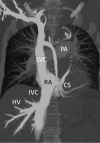Isolated Right Ventricular Stress (Takotsubo) Cardiomyopathy
- PMID: 28781307
- PMCID: PMC5596277
- DOI: 10.2169/internalmedicine.8323-16
Isolated Right Ventricular Stress (Takotsubo) Cardiomyopathy
Abstract
A 79-year-old woman was admitted with a left femoral neck fracture and she immediately developed circulatory shock. Echocardiography showed a markedly enlarged right ventricle (RV) with systolic ballooning of the mid-ventricular wall and preserved contractility of the apex. The left ventricular (LV) motion was normal. Multi-detector-row computed tomography showed severe congestion of the contrast media in the right atrium with no forward flow to RV, but no pulmonary embolism. She was successfully treated with percutaneous veno-arterial extracorporeal membrane oxygenation. This case presented with acute, profound, but reversible RV dysfunction triggered by acute stress in a manner similar to that seen in LV stress cardiomyopathy.
Keywords: cardiac magnetic resonance; circulatory shock; echocardiography; mechanical support; right heart failure; stress (takotsubo) cardiomyopathy.
Figures





References
-
- Templin C, Ghadri JR, Diekmann J, et al. . Clinical features and outcomes of takotsubo (stress) cardiomyopathy. N Engl J Med 373: 929-938, 2015. - PubMed
-
- Eitel I, von Knobelsdorff-Brenkenhoff F, Bernhardt P, et al. . Clinical characteristics and cardiovascular magnetic resonance findings in stress (takotsubo) cardiomyopathy. JAMA 306: 277-286, 2011. - PubMed
-
- Medeiros K, O'Connor MJ, Baicu CF, et al. . Systolic and diastolic mechanics in stress cardiomyopathy. Circulation 129: 1659-1667, 2014. - PubMed
-
- Tsuchihashi K, Ueshima K, Uchida T, et al. . Transient left ventricular apical ballooning without coronary artery stenosis: a novel heart syndrome mimicking acute myocardial infarction. Angina Pectoris-Myocardial Infarction Investigations in Japan. J Am Coll Cardiol 38: 11-18, 2001. - PubMed
-
- Kato K, Kitahara H, Fujimoto Y, et al. . Prevalence and clinical features of focal takotsubo cardiomyopathy. Circ J 80: 1824-1829, 2016. - PubMed
Publication types
MeSH terms
LinkOut - more resources
Full Text Sources
Other Literature Sources
Miscellaneous

